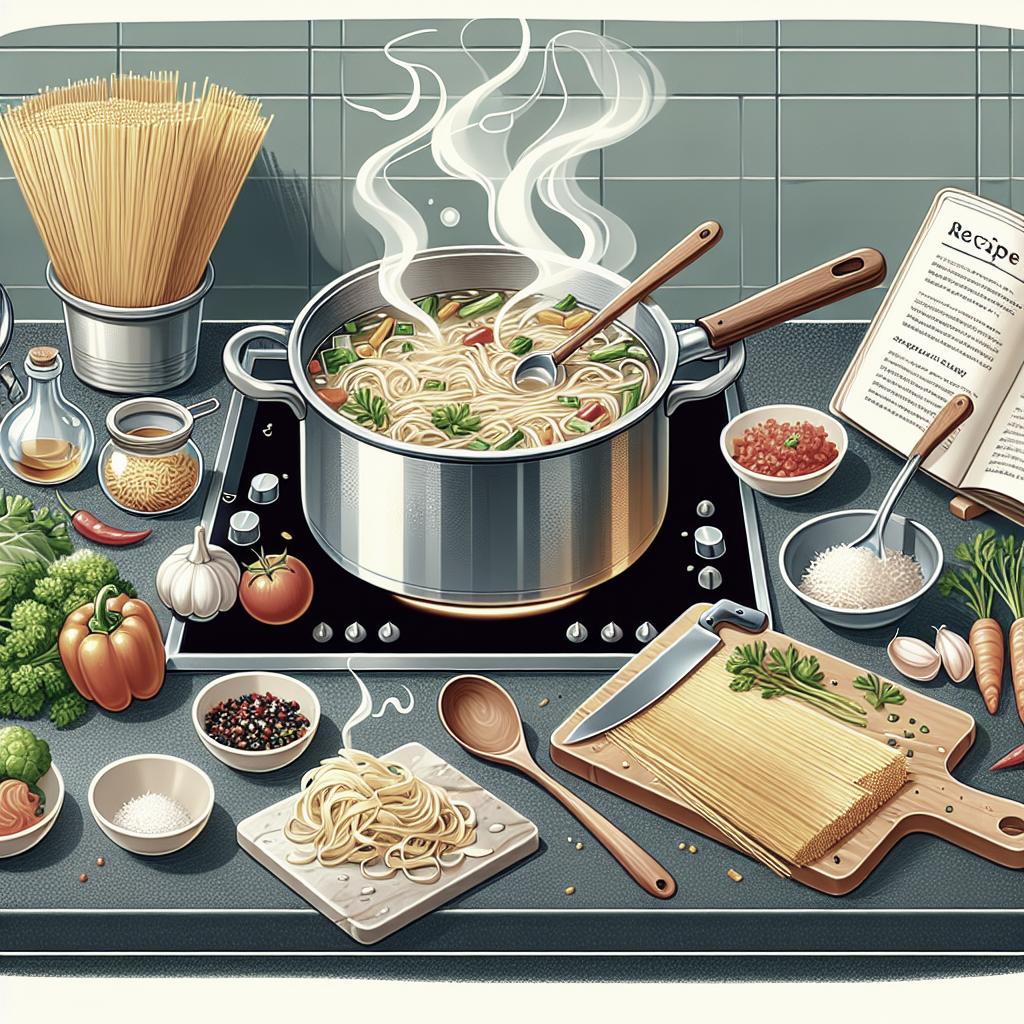Cooking Perfect Vermicelli Noodles: A Comprehensive Guide
For many, vermicelli noodles represent a staple of diverse cuisines, effortlessly complementing a range of dishes with their delicate texture and subtle taste. In this comprehensive guide, we’ll delve into everything you need to know about vermicelli—what they are, where to buy them, and how to cook them perfectly. We’ll explore tips on preventing mushiness, discuss pairing ideas, and highlight storage and reheating methods. Whether you’re a seasoned cook or just starting, this guide will equip you with the knowledge to enjoy vermicelli at its best.
What are vermicelli noodles?
Vermicelli noodles are a type of thin noodles that originate from different regions of the world, each offering a unique twist on this versatile ingredient. In Italian cuisine, vermicelli is a pasta that is slightly thicker than spaghetti, while in Asian cuisine, it refers to very thin rice or mung bean noodles commonly used in soups, salads, and stir-fries.
The primary appeal of vermicelli noodles is their ability to absorb flavors and provide a textural contrast in dishes. They can be made from various ingredients such as rice, wheat, or mung beans, which alter their taste, texture, and use in cooking. As a result, vermicelli has become a beloved choice for many chefs and home cooks who appreciate its adaptability.
Where can you buy vermicelli?
Vermicelli noodles are widely available and can be purchased from various types of retailers. For the best selection, visit an Asian supermarket, where you’ll typically find multiple brands and varieties. These specialty stores often carry the freshest noodles as well, given the high turnover rate of such products in these locations.
If an Asian market isn’t accessible, do not worry. Many well-stocked grocery stores and online retailers offer vermicelli noodles in their international foods section. With the rise of e-commerce, buying vermicelli from reputable online platforms is also a convenient alternative, ensuring a wide variety of options delivered directly to your doorstep.
My favorite vermicelli brands
Choosing a reliable vermicelli brand can significantly impact your dish’s final results. Some of my favorite brands include
Lotus Foods
for their organic rice vermicelli and
City Noodles
for their consistent texture and flavor. Both provide excellent quality, ensuring that the noodles remain springy and hold sauces well without becoming overly soft.
Another preferred brand is
A-one
, which offers delectable mung bean vermicelli. Renowned for their delicate and glassy texture, they are perfect for soups and stir-fried dishes, providing a rewarding meal experience every time. Experimenting with different brands can open up new flavors and textures that elevate your culinary creations.
How to cook vermicelli noodles properly
Cooking vermicelli noodles properly is vital to achieving the desired texture and preventing them from becoming sticky or mushy. To start, bring a pot of water to a rolling boil and add a pinch of salt. If you’re using rice vermicelli, submerge the noodles for about 3 to 5 minutes, then drain instantly. Mung bean varieties might require only 2 to 3 minutes of soaking in hot water.
It’s important to note that while cooking times can vary based on the thickness and brand of the noodles, never overcook them. After draining, utilize the shock method by rinsing with cold water to halt the cooking process, helping maintain their al dente texture. This attention to detail ensures that your vermicelli noodles will be the perfect base for any meal.
Why do you rinse vermicelli?
Rinsing vermicelli noodles is a crucial step in their preparation. Once the noodles are cooked, rinsing them under cold water helps stop further cooking by rapidly lowering their temperature. This process locks in the desired texture and ensures that the noodles don’t continue to soften, which can lead to an unappealing mushy consistency.
Moreover, rinsing removes excess starch, which often causes noodles to clump together. By washing away the starch, vermicelli noodles can remain separate and easy to toss into salads or stir-fries, enhancing your dining experience by keeping the dish’s textures and flavors distinct and vibrant.
How to prevent mushiness and clumping
Preventing mushiness and clumping in vermicelli noodles requires careful attention to cooking time and post-cooking handling. As previously mentioned, monitoring the noodles as they cook and soaking them in cold water afterwards are effective methods to preserve their firmness.
Aside from rinsing, tossing the noodles with a small amount of oil can also prevent clumping. A light coating of olive or sesame oil helps to further separate the strands, ensuring that the texture is smooth and easy to work with. This technique is particularly beneficial when preparing noodles for dishes that require tossing, such as salads and stir-fries.
What can you eat with vermicelli noodles?
The versatility of vermicelli noodles allows them to be featured in a wide array of dishes. In Asian cuisine, they are ideal for cold and hot dishes alike, such as Vietnamese spring rolls and Chinese soups. These noodles also work well in salads, offering a textural contrast when combined with fresh vegetables and proteins.
For an Italian twist, try incorporating vermicelli pasta with traditional pasta sauces or in a hearty soup. Their quick cooking nature makes them a go-to ingredient for weeknight dinners when combined with rich-tasting sauces, savory broths, or fresh herbs and parmesan cheese. This flexibility ensures that vermicelli noodles can complement any culinary preference or theme.
How do you store cooked vermicelli noodles?
Properly storing cooked vermicelli noodles is essential to maintaining their texture and flavor. Once cooked and thoroughly rinsed, transfer the noodles into an airtight container. If desired, add a few drops of oil to the noodles before sealing the container to prevent them from sticking together while refrigerated.
Place the container in the refrigerator and consume within two to three days to ensure freshness. Alternatively, you can freeze the cooked noodles for up to two months. Make sure to portion them appropriately for future use, allowing you an easy retrieval of the desired amount for quick meals, even on busy days.
How do you reheat vermicelli?
Reheating vermicelli noodles requires gentle methods to avoid overcooking and losing their delicate texture. If you refrigerated the noodles, consider heating them in a microwave-safe container with a splash of water or broth to generate steam. Cover and heat on medium power in short intervals, stirring occasionally for even warmth.
For a different approach, reheat the noodles by briefly immersing them in hot water until they are warm. Make sure to drain them well to avoid excess moisture. If using sauté or stir-fry methods, add the cold noodles to a hot pan with a small amount of oil or sauce and toss them quickly until warmed through.
Did you make this dish?
Ingredients (US Customary / Metric ½x 1x 2x)
While vermicelli noodles are simple to cook, a handful of key ingredients ensure their success. A pinch of salt, a drizzle of your preferred oil, and water are all you need to cook them. For enhancements, include tailored ingredients according to the dish in mind—like soy sauce, vegetables, or herbs.
Equipment
For preparation, you will need a large pot and a colander. These essential items ensure that your vermicelli noodles are cooked evenly and drained effectively. A mixing bowl may also be useful for tossing the noodles in oil post-cooking to prevent sticking.
Instructions
- Boil a pot of salted water and add the vermicelli noodles.
- Cook according to package instructions, typically 3-5 minutes for rice noodles.
- Drain and rinse the noodles under cold water to stop further cooking.
- Toss with a small amount of oil if storing for later use.
Notes
Be mindful to adapt cooking times based on the specific type of vermicelli used; always check package directions. When using in recipes, ensure that any additional flavors complement the dish you are assembling. Avoid overcooking by monitoring the vermicelli closely during preparation.
Final thoughts
| Section | Content |
|---|---|
| What are vermicelli noodles? | Description of vermicelli types and origins. |
| Where can you buy vermicelli? | Various sources, including Asian markets and online retailers, to purchase vermicelli. |
| My favorite vermicelli brands | Recommendations of brands and qualities. |
| How to cook vermicelli noodles properly | Step-by-step cooking process for an ideal texture. |
| Why do you rinse vermicelli? | Importance of rinsing to stop cooking and prevent clumping. |
| How to prevent mushiness and clumping | Tips such as oil tossing and careful cooking techniques. |
| What can you eat with vermicelli noodles? | Pairing suggestions and dish ideas using vermicelli. |
| How do you store cooked vermicelli noodles? | Guidelines for refrigeration and freezing methods. |
| How do you reheat vermicelli? | Safe reheating techniques to retain texture. |
| Did you make this dish? | Ingredient list, equipment needs, and preparation notes. |


